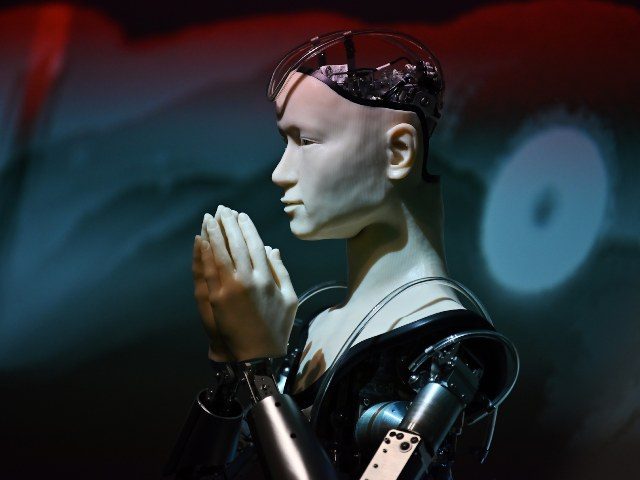A 400-year-old temple in Kyoto, Japan has installed a human-like robot to deliver the teachings of Buddha to worshipers. Foreigners are reportedly appalled, but the temple’s chief steward says that he hopes the robot will be the first of many found in Buddhist temples and that unlike Westerners, “Japanese people don’t possess any prejudices against robots.”
“This robot will never die, it will just keep updating itself and evolving,” said priest and chief steward of the temple Tensho Goto to AFP. “That’s the beauty of a robot. It can store knowledge forever and limitlessly – with AI we hope it will grow in wisdom to help people overcome even the most difficult troubles. It’s changing Buddhism.”
The robot priest – whose name is “Mindar” – was developed at the cost of nearly $1 million dollars as part of a joint project with robotics professor Hiroshi Ishiguro of Osaka University. The robot is said to be gender-neutral, and modeled after Kannon, the Buddhist deity of mercy.
“Many Buddhist statues have been made, but they were all just Buddhist images, standing or sitting figures,” said Goto. “I wanted to create a Buddhist statue which can speak, make eye contact, and answer questions, so that people can feel closer to it.”
Mindar is made of aluminum, but its hands, face, and shoulders are covered in silicon to replicate human skin. The robot was installed earlier this year in the Kodaiji temple in Kyoto, Japan, where it began preaching Buddhism.
“Young people probably think a temple is a place for funerals or weddings,” said Goto, who added that he hopes Mindar can “bridge that gap” and be able to reach younger people in a way that he believes traditional monks can’t. “It might be difficult to relate to fuddy-duddy priests like me,” said Goto.
Osaka University later polled temple-goers to collect feedback on their experiences and thoughts about Mindar, after seeing the robot preach Buddhism firsthand.
“I felt a warmth you wouldn’t feel from a regular machine,” said one temple-goer.
“At first, it felt a little unnatural, but the android was easy to follow,” replied another. “It made me think deeply about right and wrong.”
“The sermon felt uncomfortable,” said a third worshiper. “The robot’s expressions felt too engineered.”
The report added that Japanese people generally gave positive feedback regarding Mindar, while Western foreigners have expressed most of the criticism, suggesting that it is sacrilegious to have a robot deliver the teachings of Buddhism at the temple.
But Goto says that criticism from foreigners could be derived from them being influenced by the Bible, and that unlike Westerners, “Japanese people don’t possess any prejudices against robots.”
“Westerners have been the most upset by the robot,” acknowledged Goto. “It could be the influence of the Bible, but Westerners have compared it to Frankenstein’s monster.”
The chief steward said that he hopes Mindar will be the first of many robots to deliver the teachings of Buddhism in temples.
“Japanese people don’t possess any prejudices against robots,” added Goto. “We were brought up on comics where robots are our friends.”
You can follow Alana Mastrangelo on Twitter at @ARmastrangelo, on Parler at @alana, and on Instagram.

COMMENTS
Please let us know if you're having issues with commenting.